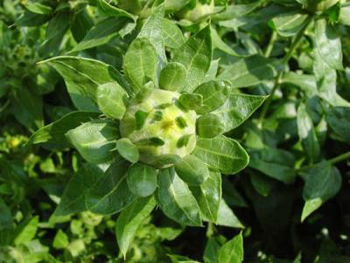Contents:
Common Names | Parts Usually Used | Plant(s) & Culture | Where Found | Medicinal Properties | Biochemical Information
Legends, Myths and Stories | Uses | Formulas or Dosages | Bibliography
Scientific Names

- Carthamus tinctorius L.
- Compositae
- Composite family
Common Names
- American saffron
- Dyers’ saffron
- False saffron
- Hung-lan-hua (Chinese name)
- Mexican saffron
Parts Usually Used
Flowers
Back to Top
Description of Plant(s) and Culture

Safflower is an annual plant; its glabrous, branching stem grows from 1-3 feet high and bears alternate, sessile, oblong, or ovate-lanceolate, dark-green, shiny, leaves armed with small spiny teeth. The orange-yellow flowers grow in flower heads made up of clusters of green bracts, topped by tufts of deep yellow florets, turning orange as they mature; about 1 to 1 1/2 inches across. It is a short lived plant. Grows in poor, dry soil, in full sun.
Unrelated to saffron, but the dried and powdered orange-red florets are used as a saffron substitute.
Back to Top

Where Found
Native to the Mediterranean countries and cultivated in Europe and the United States.
Back to Top
Medicinal Properties
Diaphoretic, diuretic, emmenagogue, analgesic, carminative
Back to Top
Biochemical Information
Carthamin, palmitic acid, stearic acid, arachic acid, oleic acid, linoleic and linolenic acids, safflower yellow
Back to Top
Legends, Myths and Stories
Some herbs are cultivated on a surprisingly large scale. In southern California, vast fields of safflower are the basis for the safflower oil industry.
Used by the Chinese in candle making.
Safflower used as a coloring for white wines. Color is similar to the very expensive saffron.
Back to Top
Uses
Taken hot, safflower tea produces strong perspiration and has thus been used for fevers, colds, and related ailments. It has also been used at times for its soothing effect in cases of hysteria, such as that associated with chlorosis. Used for delayed menses, poor blood circulation, bruises, injuries (used in liniments), and measles.
The flowers can be dried and powdered to make a saffron substitute; mixed with finely powdered talc, they make a rouge. Fresh flower petals yield dye colors ranging from yellows to reds. Flowers are used as a scent in potpourris and look nice dried in flower arrangements.
Back to Top
Formulas or Dosages
Infusion: steep 1 tsp. flowers in 1 cup water. Take 1 to 2 cups a day.
Tincture: a dose is from 20-60 drops.
Back to Top
Bibliography
![]() The Herb Book
The Herb Book, by John Lust, Bantam Books, 666 Fifth Avenue, New York, NY. copyright 1974.
![]() Chinese Medicinal Herbs
Chinese Medicinal Herbs, compiled by Shih-Chen Li, Georgetown Press, San Francisco, California, 1973.
Herbal Gardening, compiled by The Robison York State Herb Garden, Cornell Plantations, Matthaei Botanical Gardens of the University of Michigan, University of California Botanical Garden, Berkeley., Pantheon Books, Knopf Publishing Group, New York, 1994, first edition
![]() Planetary Herbology
Planetary Herbology, by Michael Tierra, C.A., N.D., O.M.D., Lotus Press, PO Box 325, Twin Lakes. WI 53181., Copyright 1988, published 1992
 Old Ways Rediscovered
Old Ways Rediscovered, by Clarence Meyer, Meyerbooks, publisher, PO Box 427, Glenwood, Illinois 60425, published from 1954, print 1988
![]() The Complete Medicinal Herbal
The Complete Medicinal Herbal, by Penelope Ody, Dorling Kindersley, Inc, 232 Madison Avenue, New York, NY 10016, First American Edition, copyright 1993
![]() Indian Herbalogy of North America
Indian Herbalogy of North America, by Alma R. Hutchens, Shambala Publications, Inc., Horticultural Hall, 300 Massachusetts Avenue, Boston, Massachusetts 02115, 1973
![]() Webster’s New World Dictionary
Webster’s New World Dictionary, Third College Edition, Victoria Neufeldt, Editor in Chief, New World Dictionaries: A Division of Simon & Schuster, Inc., 15 Columbus Circle, New York, NY 10023
![]() American Folk Medicine
American Folk Medicine, by Clarence Meyer, Meyerbooks, publisher, PO Box 427, Glenwood, Illinois 60425, 1973
![]() The Yoga of Herbs: An Ayurvedic Guide to Herbal Medicine
The Yoga of Herbs: An Ayurvedic Guide to Herbal Medicine, by Dr. David Frawley & Dr. Vasant Lad, Lotus Press, Twin Lakes, Wisconsin, Second edition, 1988.
 The Rodale Herb Book: How to Use, Grow, and Buy Nature’s Miracle Plants (An Organic gardening and farming book)
The Rodale Herb Book: How to Use, Grow, and Buy Nature’s Miracle Plants (An Organic gardening and farming book), edited by William H. Hylton, Rodale Press, Inc. Emmaus, PA, 18049., 1974
